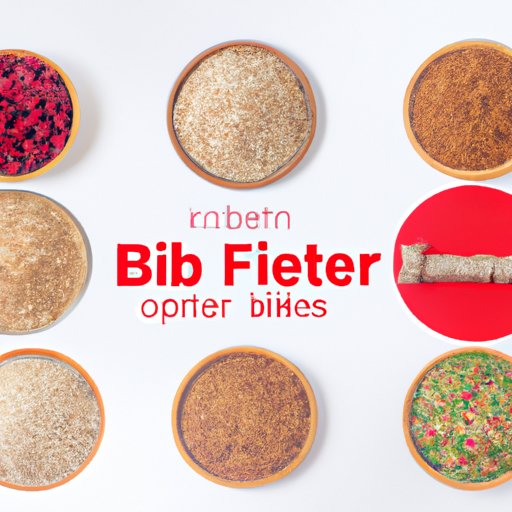
Introduction
Maintaining a healthy lifestyle involves many factors, one of which is a balanced diet. A common issue in modern diets is not getting enough fiber, which can lead to a slew of health problems. In this article, we will explore the importance of a high-fiber diet, its benefits, and how to adopt a high-fiber eating plan. We will also discuss the recommended daily intake of fiber, sources of fiber, and the risks of not getting enough of it.
Benefits of a Fiber Diet
Fiber is a type of carbohydrate found in plant-based foods that the body cannot digest or absorb. The benefits of a high-fiber diet are numerous. Studies have linked a fiber-rich diet with a reduced risk of heart disease, diabetes, and some cancers. It can lower cholesterol levels, maintain a healthy weight, and promote overall digestive health. One study showed that increasing dietary fiber by 10 grams can decrease the risk of heart disease by 14%.
How to Adopt a High-Fiber Diet: A Beginner’s Guide
Adopting a high-fiber diet can seem daunting. But with a few changes, it can become part of your daily routine. Begin by incorporating more fruits and vegetables into every meal. Choose high-fiber snacks, such as raw veggies or fruits with skin, and opt for whole grains. It’s essential to drink plenty of fluids to avoid constipation. A gradual increase in fiber intake is essential to preventing abdominal discomfort, bloating, and gas. For beginners, it’s best to increase intake slowly, allowing the body time to adjust.
Everything You Need to Know About Fiber: Types, Sources, and Intake Recommendations
There are two types of fiber: insoluble and soluble. Insoluble fiber helps keep the digestive system regular by bulking up stools and moving waste smoothly through the intestines. Soluble fiber dissolves in water and helps slow the absorption of sugar, promoting healthy blood sugar levels. Fiber can be found in various plant-based foods such as fruits, vegetables, whole grains, beans, and nuts. The recommended daily fiber intake is 25-30 grams for adults, but it can vary based on age, sex, and physical activity level.
Fiber vs. Protein: Why a High-Fiber Diet is Equally Important
A protein-rich diet has received a lot of attention. However, it is crucial to ensure a balance of both fiber and protein in your diet. A high-fiber diet complements a high-protein diet by helping maintain a healthy digestive system. Protein can help build and repair muscle tissues, but the body also needs fiber for optimal health. Both should be included in a healthy meal plan.
A Day in the Life of a Fiber-Focused Diet: Meal Prep Ideas and Recipes
Here are some meal prep ideas for a fiber-rich day. Start with a high-fiber breakfast. Overnight oats or a smoothie bowl with added fruit, nuts, and seeds is a great option. For lunch, pack a quinoa salad with fresh veggies and protein, such as chicken or tofu. In the evening, try a vegetarian chili with added beans and veggies. Snacks can include apple slices with almond butter or raw veggies with hummus. Don’t forget to drink water throughout the day.
What Happens to Your Body When You Don’t Get Enough Fiber: Risks and Side Effects
Not getting enough fiber can lead to a host of health problems, including constipation, hemorrhoids, and diverticulosis. It can also increase the risk of certain diseases such as heart disease, stroke, and some cancers. A fiber-focused diet can help prevent these issues while improving overall health and well-being.
Expert Advice on Building a Fiber-Rich Diet: Q&A with a Registered Dietitian
To gain insight into maintaining a fiber-rich diet, we interviewed a registered dietitian. They provided tips on meal planning, increasing fiber intake, and answered common nutrition-related questions.
Conclusion
Incorporating more fiber into your diet can seem overwhelming, but it’s essential for overall health and well-being. A fiber-focused diet can reduce the risk of various health problems and promote healthy digestion. Start by gradually increasing fiber intake and incorporate a variety of high-fiber foods. Remember to drink plenty of fluids and consult a registered dietitian if you have any questions or concerns. A high-fiber diet is essential for leading a healthy lifestyle.




